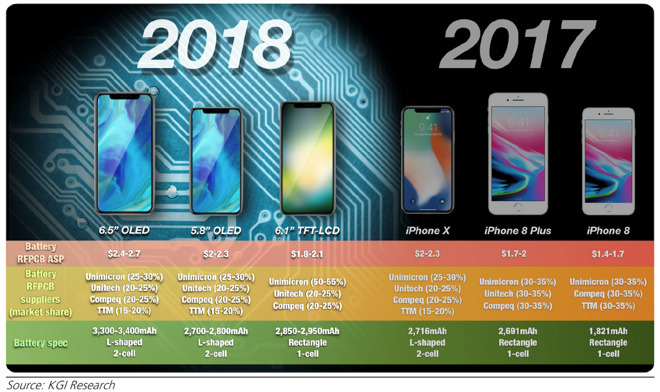Apple market analyst Ming-Chi Kuo is back again with a new report, answering some investors' main questions about the 2018 Apple product lineup.
Much of the report supplied to AppleInsider clarifies author Ming-Chi Kuo's previous reports on the Apple ecosystem, and focuses on Apple suppliers. However, there are key tidbits that can be gleaned from the report.
Kuo is expecting a "new low-price MacBook Air" still — which he previously claimed in March. Also still expected by the analyst is an Apple Watch with approximately the same size, but a larger screen.
Kuo also wrote about the 2018 iPhone lineup in the most recent note. He reiterated his previous claims about the device, but expects that Apple's innovations in the space may not be clear to the supply chain until very close to release.
Ku believes that Apple's growth mostly comes from replacement demands in the high-end market, and new users on the low-end, as buttressed by a report from earlier on Tuesday. Slow growth is from there being "no significant replacement demands boosted by new models after the iPhone 6."
"We believe that Apple is still the leading company in the consumer electronics sector and has surpassed its competitors by a wide margin in terms of innovative user experience and ecosystem development," writes Kuo. "The leading advantages will benefit it when innovating with new applications."
The three iPhone models currently speculated to arrive this fall include two models with OLED screens measuring 6.5 inches and 5.8 inches, while a third is equipped with a 6.1-inch TFT LCD. Most sources now claim that all three will have the TrueDepth camera array and use Face ID, but the LCD model will be singled out as a cost-effective model while the OLED versions will have more premium pricing and specifications.
There is some speculation that the LCD model will be delayed, due to production yield issues surrounding its touchscreen functionality, but the situation is apparently improving. Bottlenecks in integrating the TrueDepth camera array into the LCD screen are also said to be easing, removing another hurdle that could cause manufacturing delays.
Foxconn will continue to be the main iPhone assembler this year, with it said to handle all 5.8-inch OLED units and 80 to 90 percent of the 6.5-inch OLED version, as well as 30 percent of LCD model orders. Pegatron is identified as taking 60 percent of the LCD orders and between 10 and 15 percent of the 6.5-inch OLED model orders, while Wistron makes up the remainder.
Apple CEO Tim Cook has previously spoken out about such reporting and supply chain analysis, advising for industry observers to avoid relying too heavily on these types of rumors. "The supply chain is very complex, and we obviously have multiple sources for things," Cook advised in 2013, adding that some reports could be based on a "single data point," and basing assumptions on limited quantities of data is not recommended.
Amplifying Cook's words of caution, reports in January claimed Apple had cut its iPhone X production, citing slower-than-expected holiday sales" among other claims. On February 1, Apple revealed it had continued to improve its holiday quarter revenue year-on-year, and though overall iPhone sales had dropped, it had reduced by only 1.2 percent year-on-year with a holiday quarter with one less week than the previous year while simultaneously achieving the highest average selling price of $796.42.
 Mike Wuerthele
Mike Wuerthele







-m.jpg)






 Thomas Sibilly
Thomas Sibilly
 Wesley Hilliard
Wesley Hilliard
 Marko Zivkovic
Marko Zivkovic

 Malcolm Owen
Malcolm Owen

 Amber Neely
Amber Neely
-xl-m.jpg)









48 Comments
Smartphone sales have been down overall.
Can't wait to upgrade to the 6.5 OLED.
If the new MacBook Air is in the pipeline, it will likely have the new, flawed, butterfly keyboard and the USB-C ports that nobody wanted.
These seem like reasonable expectations for 2018.
I'm oddly on my 2nd year of my iPhone 7 and I'm not sure I'll get a new iPhone later this year either. I'm more inclined to get a new Apple Watch if it has features that I want, or even just keep the one I have. I hope that 3rd-party audio from Spotify and SiriuxXM are quick to launch independent apps so I can help distance my reliance on my iPhone.